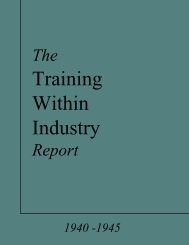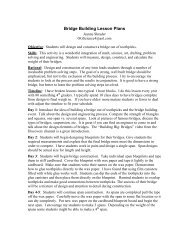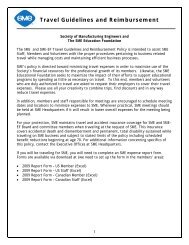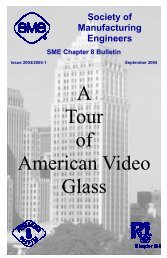Training Within Industry in the United States by Channing R. Dooley
Training Within Industry in the United States by Channing R. Dooley
Training Within Industry in the United States by Channing R. Dooley
Create successful ePaper yourself
Turn your PDF publications into a flip-book with our unique Google optimized e-Paper software.
TRAINING WITHIN INDUSTRY IN TH& UNITED STATES 161<br />
<strong>in</strong>volves people". Such a def<strong>in</strong>ition should clearly dist<strong>in</strong>guish<br />
"tra<strong>in</strong><strong>in</strong>g" from "education", s<strong>in</strong>ce "education" means to most<br />
people anyth<strong>in</strong>g and everyth<strong>in</strong>g from develop<strong>in</strong>g a background of<br />
<strong>in</strong>formation to acquir<strong>in</strong>g a specific trade skill which helps an <strong>in</strong>dividual<br />
to meet <strong>the</strong> requirements of society. Education has to do<br />
'with knowledge and understand<strong>in</strong>g, whereas tra<strong>in</strong><strong>in</strong>g as discussed<br />
here is directed action <strong>in</strong> <strong>the</strong> use of knowledge. <strong>Industry</strong> has <strong>the</strong><br />
opportunity now to build a bridge from knowledge to action, to<br />
put knowledge to use <strong>in</strong> <strong>the</strong> shortest possible time.<br />
THE NECESSITY FOR TRAINING<br />
<strong>Tra<strong>in</strong><strong>in</strong>g</strong> is not a departmental activity. It is not an employee<br />
benefit, nor ib it someth<strong>in</strong>g to be left to <strong>the</strong> ambition of <strong>in</strong>dividual<br />
employees. Ra<strong>the</strong>r it is a management tool where<strong>by</strong> specific people<br />
are given help <strong>in</strong> acquir<strong>in</strong>g def<strong>in</strong>ite skill <strong>in</strong> overcom<strong>in</strong>g underly<strong>in</strong>g<br />
causes of problems that currently exist or that are anticipated <strong>by</strong><br />
management. <strong>Tra<strong>in</strong><strong>in</strong>g</strong> is not someth<strong>in</strong>g that is done once to new<br />
employees - it is used cont<strong>in</strong>uousIy <strong>in</strong> every well-&; establishment.<br />
Every time you get someone to do work <strong>the</strong> way you want<br />
it done, you are tra<strong>in</strong><strong>in</strong>g. Every time you give directions or discuss<br />
a procedure, you are tra<strong>in</strong><strong>in</strong>g. Therefore, tra<strong>in</strong><strong>in</strong>g is not someth<strong>in</strong>g<br />
which, though desperately needed when <strong>in</strong>dustry was expand<strong>in</strong>g<br />
to meet war orders, can be forgotten now that plants are shr<strong>in</strong>k<strong>in</strong>g<br />
<strong>in</strong> size and go<strong>in</strong>g back to civilian work and <strong>the</strong> latest labour recruits<br />
are be<strong>in</strong>g replaced <strong>by</strong> employees home from <strong>the</strong> wars. In<br />
many cases, especially where a change-over <strong>in</strong> products or <strong>in</strong> processes<br />
is <strong>in</strong>volved, it will be just as essential to successful operation<br />
as it was with new employees <strong>in</strong> wartime.<br />
Dur<strong>in</strong>g wartime, plants needed to use tra<strong>in</strong><strong>in</strong>g <strong>in</strong> order to<br />
supply <strong>the</strong> needs of <strong>the</strong> armed forces. Now, plants must use tra<strong>in</strong><strong>in</strong>g<br />
if <strong>the</strong>y are go<strong>in</strong>g to survive <strong>in</strong> competitive situations and if<br />
<strong>the</strong>y are go<strong>in</strong>g to keep on provid<strong>in</strong>g jobs and wages for workers.<br />
The Responsibility for <strong>Tra<strong>in</strong><strong>in</strong>g</strong><br />
Responsibility for tra<strong>in</strong><strong>in</strong>g cannot be shunted off on a tra<strong>in</strong><strong>in</strong>g<br />
man with a direction to go ahead or do what he pleases as long as<br />
he does not bo<strong>the</strong>r l<strong>in</strong>e supervision. <strong>Tra<strong>in</strong><strong>in</strong>g</strong>, to be effective, must<br />
be accepted <strong>by</strong> <strong>the</strong> management as an <strong>in</strong>tegral part of production<br />
procedure, and <strong>the</strong> l<strong>in</strong>e supervision <strong>in</strong> <strong>the</strong> plant must be responsible<br />
for tra<strong>in</strong><strong>in</strong>g <strong>the</strong> men <strong>the</strong>y supervise. The l<strong>in</strong>e organisation itself<br />
must name its problems, must dig <strong>in</strong>to <strong>the</strong> reasons why <strong>the</strong>y exist, 'J<br />
must help to work out what would br<strong>in</strong>g about an improvement








